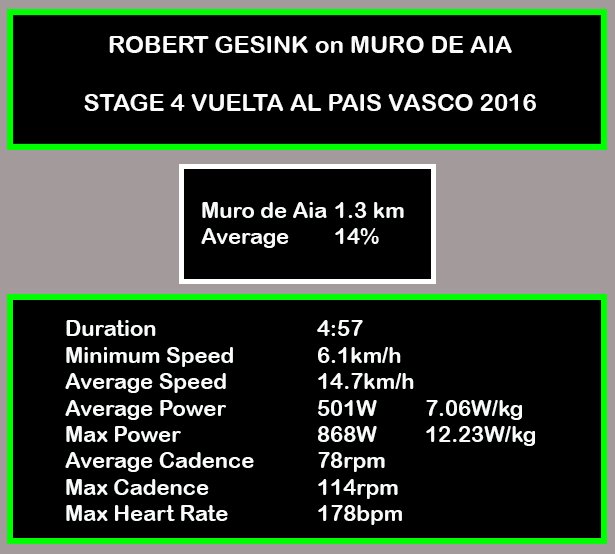I am not allowed to open a thread about the difference of times and some riders still riding with thoe wonderfull years, so I put here things in relation:
Arrate-Usartza
2016:4,4 km@9,3%---13:15---average speed 19.92 km/h(Contador-Henao)
2015:4,4 km@9,3%---12:48---average speed 20.63 km/h(Henao-Zakarin)
2014:4,4 km@9,3%---13:04---average speed 20.20 km/h(Wout Poels)
2013:4,4 km@9,3%---13:33---average speed 19.48 km/h(Simon Spilak)
2012:4,4 km@9,3%---12:58---average speed 20.36 km/h(Contador-Valverde-Rodriguez-Froome)
2012:4,4 km@9,3%---13:06---average speed 20.15 km/h(Horner-S.Sanchez-Rodriguez)
2011:4,4 km@9,3%---13:03---average speed 20.23 km/h(Xavier Tondo)
2010:4,4 km@9,3%---12:32---average speed 21.06 km/h(Chris Horner)
2009:4,4 km@9,3%---12:12---average speed 21.64 km/h(Alberto Contador)
1992:4,4 km@9,3%---12:42---average speed 20.79 km/h(Franco Chioccioli)
1991:4,4 km@9,3%---13:24---average speed 19.70 km/h(Bugno-Indurain-Ugrumov)
From 2011 about 30 second more average, but some people are still saying nobody changed. and in the dark era where people wining clean, as Hamilton said in his book.
Contador is still at his best sshape, but 1 minute slower today... those wonderfull years...Yes,without rain today and Matsaria maybe I admit 20-30 seconds better, but far from his record.
Purito was similar in time to 2009, so in perform considering today conditions, a little bit better.
Franck Schleck was close to today Contador-Henao time. (and it wanst a good day for him, he was 21). Today he was 33, but 6 minutes slower than in 2009. he is younger than Purito, so it is not the age.
People can take his conclusions...
 )
)





